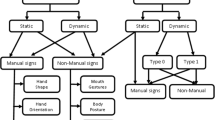Abstract
This paper reviews few important and contemporary research contributions in the field of sign language biometrics, especially Indian sign language (ISL) biometrics. The current research study suggests that the work in this area is very limited in Indian context and therefore we have reviewed the existing work on ISL or similar biometrics for different languages. The scope of potential research in ISL biometrics is development of databases since there is no standard database for ISL biometrics. The paper recommends the directions and viable method that could lead to a robust biometrics which would be very useful communication means for hearing and speech impaired people. A database was created as sample and tested using a standard method, scale invariant feature transform (SIFT) method and found that the database worked in ISL biometric system. The suggestions and anticipations of a organization working for deaf and dumb people have also been studied.

Similar content being viewed by others
References
Ahmad B, Hassanat A, Alhasanat MB, Abbadi MA, Mouhammd EB, Al-Awadi, Tarawneh AS (2016) Victory sign biometric for terrorists identification. Cornel University Library
Mashagba EFAl, Zarqa University, Jordan (2016) Human identification based on geometric feature extraction using a number of biometric systems available: review. Comput Inf Sci 9(2):140–155
Donner A (2012) A biomechanical assessment of early and late sign language learners: impact on work style and musculoskeletal disorder risk. Rochester Institute of Technology, New York
Wang L, Weiming Hu, Tan T (2013) Recent developments in human motion analysis. Pattern Recogn 36(03):585–601
Amin T (2013) Dynamic descriptors in human gait recognition. Thesis of Doctor of Philosophy, Graduate Department of Electrical and Computer Engineering, University of Toronto
Büyüksaraç B (2015) Sign language recognition by image analysis. Master’s Thesis, Graduate School of Natural and Applied Sciences, Master of Science in Electrical and Electronics Engineering, Middle East Technical University
Lisztes Á, Antal Á, Gaudia A, Korondi P (2005) Sign language in the intelligent sensory environment. Acta Polytechnica Hungarica 2(1):109–121
El-Bendary N, Zawbaa HM, Daoud MS, Hassanien AE, Nakamatsu K (2011) ArSLAT: Arabic sign language alphabets translator. Intern J Comput Inf Syst Ind Manag Appl 3:498–506
Amin A (2009) Gabor wavelets for human biometrics. PhD Thesis, City University of Hong Kong
Samoil S (2016) Hand biometrics for contactless interfaces. Thesis of Master of Science, Electrical Engineering, University of Calgary
Moscatiello J (2014) Designing and evaluating a system for the effective analysis of sign language video content for the improvement of video quality. Thesis of Master of Science, Computer Science, Ryerson University, Toronto, Ontario, Canada
Riad AM, Elmonier Hamdy K, Shohieb Samaa M, Asem AS (2012) Signs world; deeping into the silence world and hearing its signs (state of the art). Intern J Comput Sci Inf Technol (IJCSIT) 4(1):189–208
Raheja JL, Singhal A, Sadab. Android based portable hand sign recognition system. https://arxiv.org/ftp/arxiv/papers/1503/1503.03614.pdf
Paulchamy B, Jaya J (2016) Proficient technique to communicate and detect emotion of differently-abled persons using sensor devices and electroencephalogram signals. Asian J Resin Soc Sci Humanities 6(8):179–195
Patil S, Sinha GR (2015) Intensity based distinctive feature extraction and matching using scale invariant feature transform for Indian sign language. Mathematical methods and systems in science and engineering, WSEAS Conference Tenerife 245–255
Pansare JR, Gawande SH, Ingle M (2012) Real-time static hand gesture recognition for American sign language (ASL) in complex background. J Signal Inf Process 3:364–367
Sinha GR, Patil S (2013) Biometrics: concepts and applications. Wiley India Publications, New Delhi
Tamboli D, Patil S, Sinha GR (2014) Technical challenges for biometric science. Int J Comput Sci Netw 2014:165–170
Singhal N (2016) Indian sign language font: helping hands. Typography Day at MSU Faculty of Fine Arts, Baroda 25–27
Indian sign language materials, Deaf-Enabled Foundation. http://def.org.in/indian-sign-language-materails/
Indian sign language classes, Deaf-Enabled Foundation. http://def.org.in/indian-sign-language-classes/
Referral interpreter service, Deaf-Enabled Foundation. http://def.org.in/referral-interpreter-service/
Author information
Authors and Affiliations
Corresponding author
Rights and permissions
About this article
Cite this article
Sinha, G.R. Indian sign language (ISL) biometrics for hearing and speech impaired persons: review and recommendation. Int. j. inf. tecnol. 9, 425–430 (2017). https://doi.org/10.1007/s41870-017-0049-0
Received:
Accepted:
Published:
Issue Date:
DOI: https://doi.org/10.1007/s41870-017-0049-0




